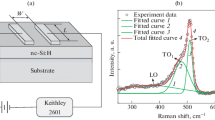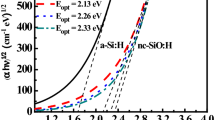Abstract
Lightly doped hydrogenated amorphous silicon thin films were deposited through the plasma enhanced chemical vapor deposition (PECVD) technique using a gas mixture of SiH4, B2H6, and H2 as the precursor. By using thermal annealing at 800 and 1000°C, boron doped nanocrystalline silicon films were obtained. X-ray photoelectron spectroscopy (XPS) measurements demonstrated the presence of substitutional boron in the doped films. Based on the measurement of dark conductivity as a function of temperature, p-type nanocrystalline silicon (nc-Si:H) films with high room temperature conductivity and low active energy were observed. By using these p-type silicon films, P-N junction solar cells were prepared on the n-type nc-Si substrate. The device characteristics were investigated based on the measurements of the current-voltage and spectral-response.
中文摘要
本文采用等离子体增强化学气相沉积技术(PECVD)制备了轻度掺杂的氢化非晶硅薄膜, 沉积过程中以SiH4, B2H6 和 H2 的 混和气作为反应源. 原始淀积材料经过800和1000°C的高温热退火处理后, 形成了硼掺杂的纳米硅薄膜. X射线光电子能谱(XPS)显示硼 原子在薄膜中形成了替位式掺杂. 根据不同温度下暗电导率的测量结果, 轻度硼掺杂的纳米硅薄膜具有较高的室温暗电导率和较低的 激活能. 进而, 采用该种P型硅薄膜材料以N型单晶硅为基底, 制作了P-N结太阳能电池器件. 根据电流-电压特性以及光谱相应曲线的测 量分析, 对电池的性能特性进行了研究.
Similar content being viewed by others
References
Das D, Bhattacharya K. Chara cterization of the Si:H network during transformation from amorphous to micro-and nanocrystalline structures. J Appl Phys, 2006, 100: 103701
Yoshida N, Shimizu Y, Honda T, et al. A study of absorption coefficient spectra in a-Si:H films near the transition from amorphous to crystalline phase measured by resonant photothermal bending spectroscopy. J Non Cryst Solids, 2008, 354: 2164–2166
Leary SK, Malik SM. A simplified joint density of states analysis of hydrogenated amorphous silicon. J Appl Phys, 2002, 92: 4276–4282
Hu GY, Connell RF, He YL, et al. Electronic conductivity of hydrogenated nanocrystalline silicon films. J Appl Phys, 1995, 78: 3945–3948
Yan WS, Wei DY, Guo YN, et al. Low-temperature preparation of phosphorus doped µc-Si:H thin films by low-frequency inductively coupled plasma assisted chemical vapor deposition. Thin Solid Films, 2012, 520: 1724–1728
Saleh R, Nickel NH. Raman spectroscopy of B-doped microcrystalline silicon films. Thin Solid Films, 2003, 427: 266–269
Satoa K, Hirakuri K. Influence of paramagnetic defects on multicolored luminescence from nanocrystalline silicon. J Appl Phys, 2006, 100: 114303
Fathi E, Vygranenkob Y, Vieira M, et al. Boron-doped nanocrystalline silicon thin films for solar cells. Appl Surf Sci, 2011, 257: 8901–8905
Juneja S, Sudhakar S, Gope J, et al. Highly conductive boron doped micro/nanocrystalline silicon thin films deposited by VHF-PECVD for solar cell applications. J Alloy Compd, 2015, 643: 94–99
Cao YQ, Xu X, Li SX, et al. Improved photovoltaic properties of Si quantum dots/SiC multilayers-based heterojunction solar cells by reducing tunneling barrier thickness. Front Optoelectron, 2013, 6: 228–233
Song C, Xu J, Wang Q, et al. Carrier transport of doped nanocrystalline Siformed by annealing of amorphous Sifilms at various temperatures. Solid State Commun, 2011, 151: 697–700
Song C, Chen GR, Xu J, et al. Evaluation of microstructures and carrier transport behaviors during the transition process from amorphous to nanocrystalline silicon thin films. J Appl Phys, 2009, 105: 054901
Chen H, Gullanar MH, Shen WZ. Effects of high hydrogen dilution on the optical and electrical properties in B-doped nc-Si:H thinfilms. J Cryst Growth, 2004, 260: 91–101
Myong SY, Lim KS, Konagai M. Effect of hydrogen dilution on carrier transport in hydrogenated boron-doped nanocrystalline silicon- silicon carbide alloys. Appl Phys Lett, 2006, 88: 103120
Shah A, Meier J, Vallat-Sauvain E, et al. Microcrystalline silicon and ‘micromorph’ tandem solar cells. Thin Solid Films, 2002, 403-404: 179–187
Song C, Xu J, Chen G, et al. High-conductive nanocrystalline silicon with phosphorous and boron doping. Appl Surf Sci, 2010, 257: 1337–1341
Author information
Authors and Affiliations
Corresponding author
Additional information
Chao Song received his PhD degree in microelectronics and solid state electronics from the Department of Physics of Nanjing University in 2010. His research interests are focused on the fabrication of silicon-based nanomaterials, and the development and understanding of doped materials for energy and light emission related applications, such as solar cells and LEDs.
Rights and permissions
About this article
Cite this article
Song, C., Wang, X., Song, J. et al. Boron doped nanocrystalline silicon film characterization for solar cell application. Sci. China Mater. 58, 704–708 (2015). https://doi.org/10.1007/s40843-015-0086-6
Received:
Accepted:
Published:
Issue Date:
DOI: https://doi.org/10.1007/s40843-015-0086-6




